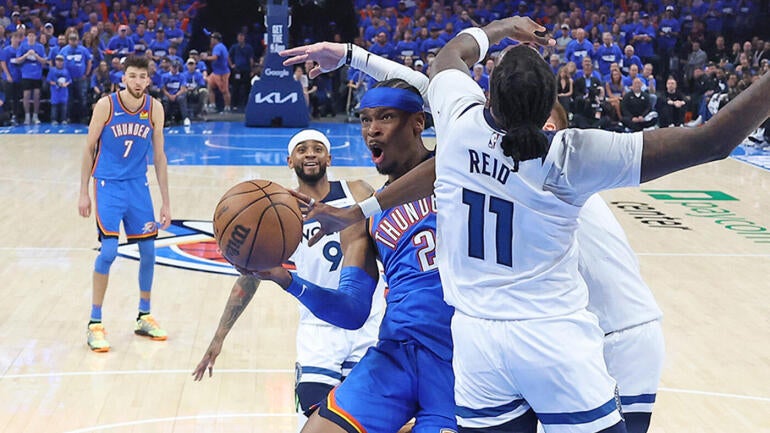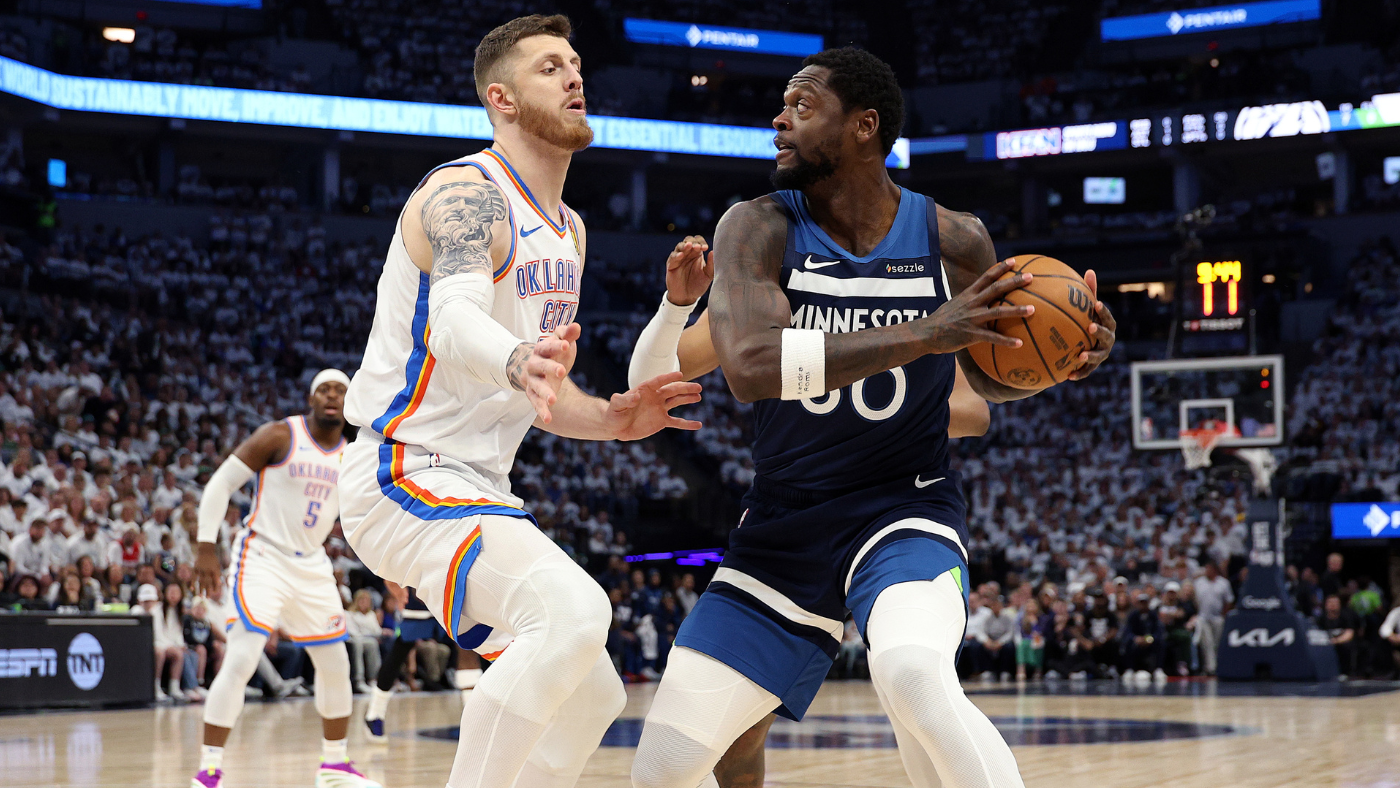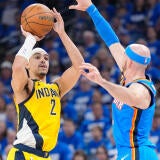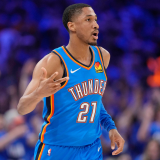How Shai Gilgeous-Alexander gives the Thunder easy offense, and how Oklahoma City takes Minnesota's away
The MVP makes life easy for the Thunder, who bring a 2-0 series lead into Minneapolis on Saturday

What comes to mind when you hear the words "easy points" in an NBA game? Maybe a steal and a breakaway layup or dunk, but I would argue there was difficulty attached to generating the turnover. The same is true for free throws. The shots themselves are easy. The process that led to them often wasn't.
No, let me show you what easy points look like in even the highest-leverage professional basketball games. On Thursday night, the Oklahoma City Thunder hosted the Minnesota Timberwolves for Game 2 of the Western Conference finals. Around halfway through the first quarter, Lu Dort made a 3-pointer practically without moving.
I wanna highlight one very simple play from Game 2 that shows how much easier SGA makes life for his teammates.
— Sam Quinn (@SamQuinnCBS) May 23, 2025
Lu Dort doesn't move on this play. Like, at all. But SGA draws three defenders around the nail, so wide-open 3. Just exist in his orbit and you're getting clean looks. pic.twitter.com/vkLXiEnavq
OK, technically, he at least ran up the court. But once he reached his station on the wing, he just sort of hung out. He didn't run around a screen or set one himself. He didn't even rotate into an open position. He just walked down the court and waited for the MVP to do his thing.
Dort made the shot, but Shai Gilgeous-Alexander created it. Take your eyes off of Dort for a moment. Trust me, he's not going anywhere. The play itself is pretty straightforward. Jalen Williams brings the ball up the court and passes the ball to Isaiah Hartenstein on the left wing. He takes two dribbles before he sticks an easy pocket pass between Rudy Gobert and Jaden McDaniels. At this point, Minnesota panics. Gobert falls into the paint. McDaniels sticks with Gilgeous-Alexander. Julius Randle stunts off of Dort to offer yet more resistance against the league's preeminent driver.
That's all it takes. The moment Gilgeous-Alexander has the ball at the nail, three Minnesota defenders have all converged on him. Oklahoma City gets those easy points because Minnesota knows just how hard it is to defend Gilgeous-Alexander. His rim gravity as a driver is so immense that his teammates can get clean looks from 3-point without moving. Almost every Gilgeous-Alexander drive puts Minnesota in a bind like this. If you don't help, he scores. If you do, well, easy points.
On Saturday night, Gilgeous-Alexander will lead the OKC charge again against the Timberwolves in Game 3.

Gilgeous-Alexander isn't the only player in the league or in this series with rim gravity. Anthony Edwards obviously has plenty of it himself. Randle does too, and on paper, it certainly looks like they're using it to give the Timberwolves good shots. The Timberwolves have generated 48 wide-open 3s in the first two games of this series, according to NBA.com tracking data. That's 24 per game. Only the Bulls averaged more of them in the regular season.
But you've watched these games. None of this feels like good offense. The Timberwolves aren't scoring. That's what makes this Thunder team so special. They're so good on defense that even the open shots they allow aren't necessarily good ones.
Oklahoma City opponents shot only 37.2% on wide-open 3s this regular season. That was tied, ironically enough, with Minnesota for the lowest mark in the NBA. Normally, we'd chalk up wide-open shooting percentages to luck. In most cases, when a team has generated a wide-open 3, it has won. That's the shot they wanted to create. A defense can't control if a shooter makes a wide-open 3. Even Stephen Curry is likelier to miss one than make one.
But look at the playoff numbers, too. Once again, the Thunder are at the bottom at 31.9%. Look at each individual series they've played. Minnesota is making 29.2% of these shots. Denver made 33.6%. Memphis made 30.2%. All three figures, individually, are worse than any other playoff team has shot on wide-open 3s this postseason besides Orlando. Minnesota's opponents haven't struggled nearly as much. The Lakers shot 40% on wide-open 3s against them. The Warriors, largely without Curry, shot 41.3%. We're dealing with small samples here, but it seems notable that while these two teams allowed identical percentages on wide-open 3s in the regular season, the Thunder have been significantly better in the playoffs.
That's because, as good as Minnesota's defense is in a vacuum, it pales in comparison to Oklahoma City's historic unit. The Thunder defense was more than two points per 100 possessions better than any other defense in the NBA in the regular season and more than five points better than Minnesota's. Over the course of the regular season, they allowed 256 fewer points in the paint than any other team and generated 67 more turnovers.
What does any of this have to do with wide-open shooting percentages? Well, there's a big difference between the sort of wide-open shot that Dort took in the video above and the sort of wide-open shot the Timberwolves are taking in this series. It's pretty easy to maintain your poise and mechanics when you don't even have to move to get open. But the Thunder are so fast and so aggressive that merely being on the floor with them rushes opposing shooters. They know that their offense isn't going to generate points in the paint, they know that if they pass the ball, it could very easily be stolen, and they know that if they don't press their advantage the moment they generate it, Oklahoma City's lightning-quick closeouts will take that advantage away. So they fire up shots as quickly as possible, and, predictably, a lot of them miss the mark.
If the Thunder win the championship in a few weeks, this will be perhaps the biggest reason why. Their league MVP gives them some of the easiest points in the playoffs, and their defense makes sure their opponents never get the same opportunities.
![[object Object] Logo](https://sportshub.cbsistatic.com/i/2020/04/22/e9ceb731-8b3f-4c60-98fe-090ab66a2997/screen-shot-2020-04-22-at-11-04-56-am.png)



















